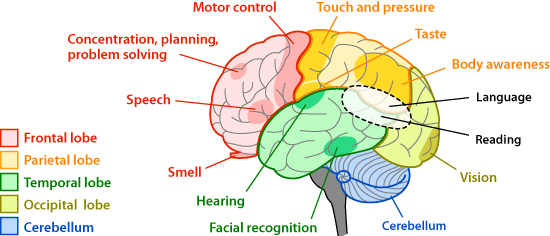The following excerpt from the book Teaching and Learning in the Kindergarten Year by Dominic Gullo describes brain development in the early years.
During pre-school and Kindergarten, the brain grows steadily, increasing from seventy percent to ninety percent of its eventual adult weight. In addition to gains in size, the brain undergoes considerable reshaping and refining. Among these modifications are profound changes in the frontal lobes-areas of the brain devoted to regulating thought and action. The frontal lobes govern the inhibition of impulse, orderly memory, and the integration of information- capacities that facilitate reasoning and problem solving. All these skills improve considerably in kindergarten children.
Throughout the preschool years, the brain overproduces connections between neurons. At about age four and five children have nearly double the number of synapses in some brain areas, such as the frontal lobes, that adults have. This overabundance of communication channels supports the brain’s plasticity or high capacity for learning. It helps ensure that a child will be able to acquire basic human abilities even if some brain areas happen to be damaged.
The first five to seven years of life are a sensitive period for brain development. During this time, the brain is especially responsive to stimulation, which prompts this massive wiring of neurons and sculpting of brain regions. The brain is more malleable than it will be later, making pre-school and kindergarten the optimal time for learning and effective intervention with all children. The brain lays down its basic organization in 2 phases: the preschool and K years and then in the regular school years. Neuroscientists and child development researchers refer to the first phase (pre-K and K) as experience-expectant brain growth, underscoring that young children need a wide variety of ordinary experiences during this phase-opportunities to see and touch objects, hear language and other sounds, and move about and explore the environment. The brain expects to encounter these experiences and if it does, it will grow normally. A second phase, called experience-dependent brain growth, becomes increasingly dominant during the school years. It involves the refinement of established brain structures as a result of specific activities, which vary widely across individuals and cultures. Learning to read and write very well, play computer games, weave an intricate rug, tend a garden, play the violin are examples of such activities.The author goes on to say that you don’t want to push the second phase too early. Instead of rushing through the first phase, we need to just do that first phase really well.
Later chapters in the book describe how the kindergarten year requires a nuanced balance: plenty of play, choice, verbal interaction, and learning of foundational skills. Classrooms also should be rich in engaging activities that are adaptable to children’s varying readiness for experience-dependent learning. Kindergartners learn best under conditions in which adults guide and support their active efforts, with gradual and measured introduction of more formal lessons.
The brain is growing rapidly during the pre-K and Kindergarten years. In Kindergarten, the child needs a balance of experience-expectant brain growth activities and the start of experience-dependent brain growth activities.
REFERENCE
Gulo, D. F. (2006). Teaching and Learning in the Kindergarten Year. Washington,
DC: National Association for the Education of Young Children.



